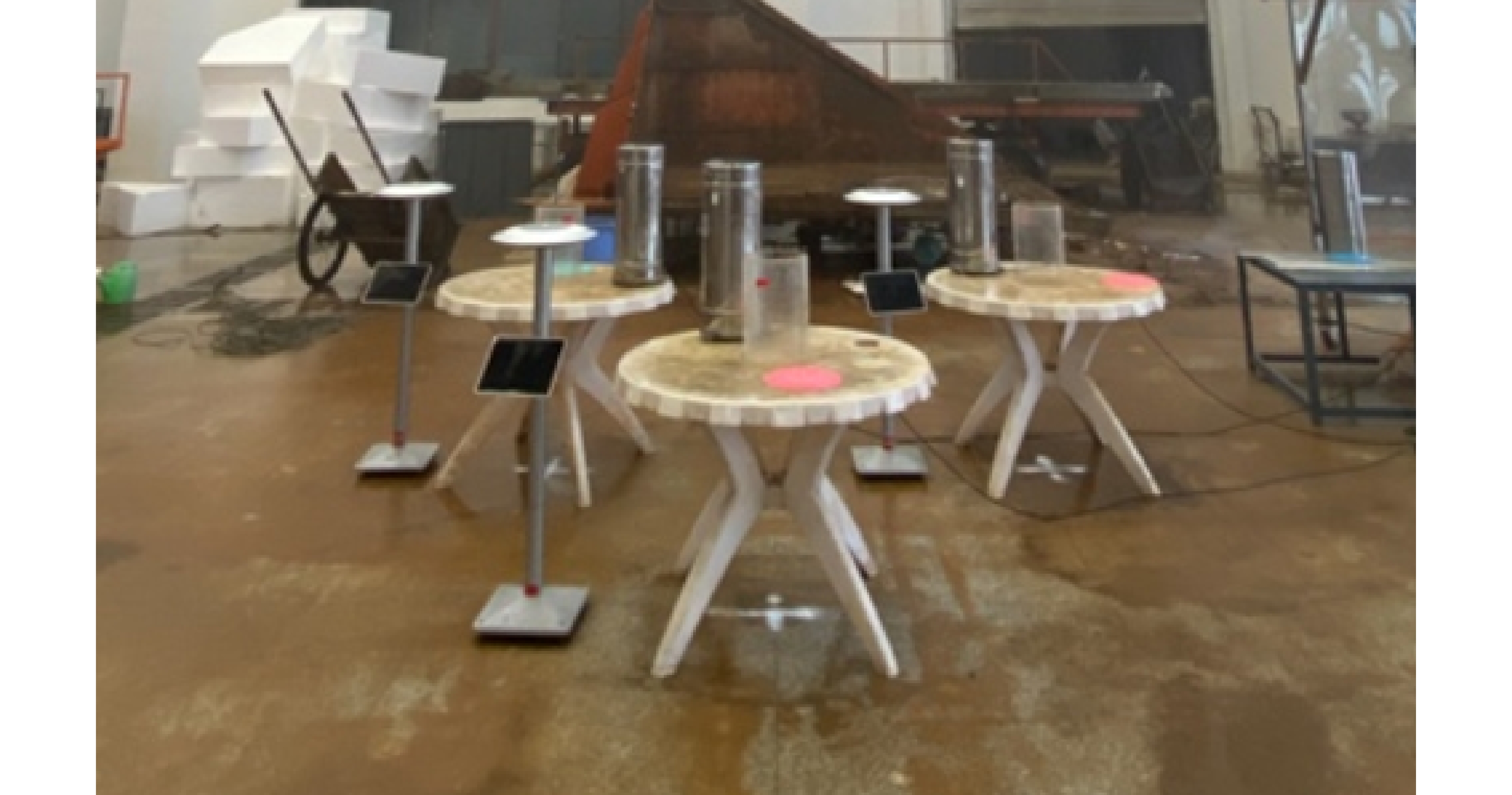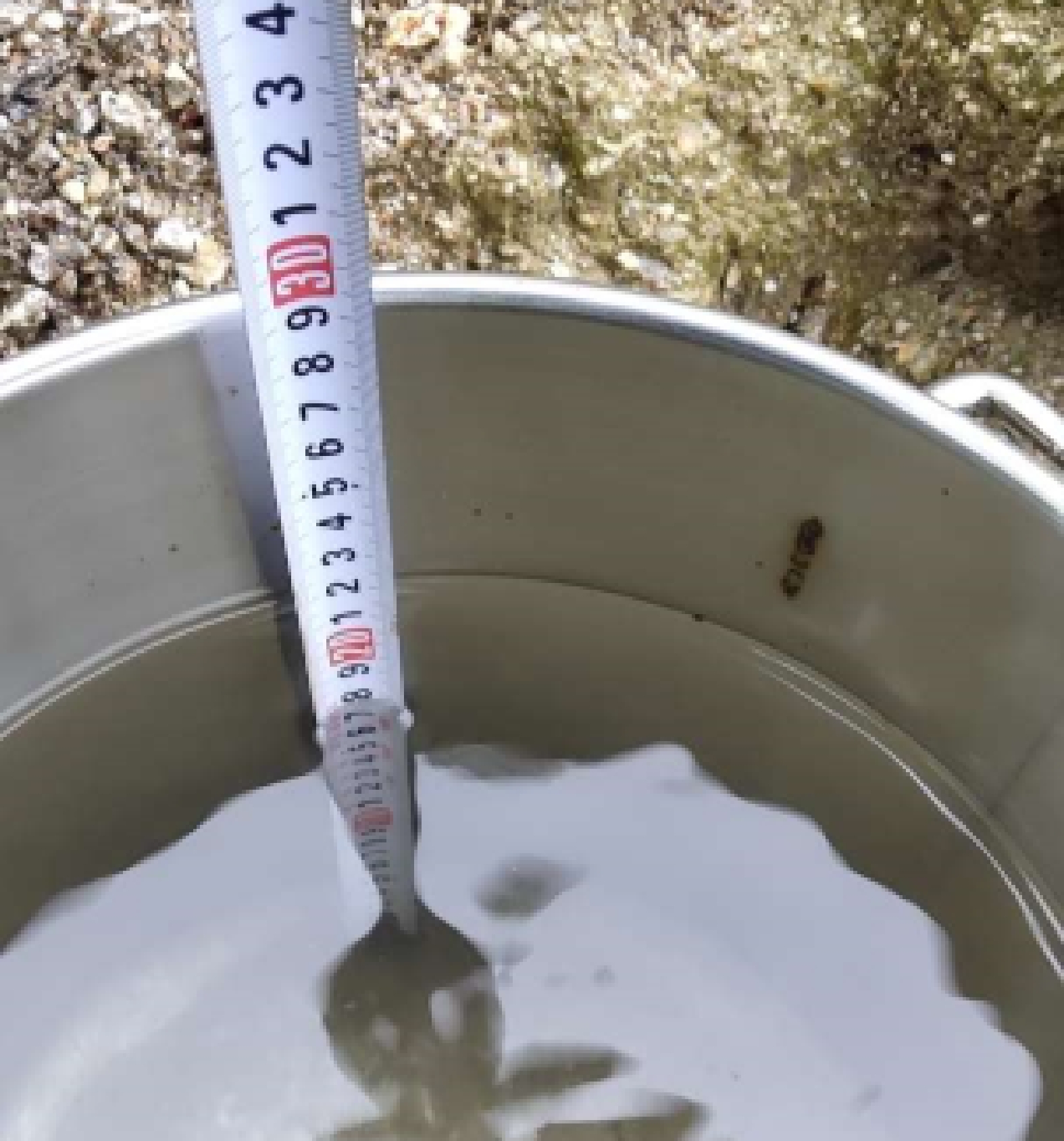Precision calibration and suitability analysis of piezoelectric rain gauges for complex scenarios in geological hazard monitoring
-
摘要: 降雨尤其是局地集中强降雨是诱发滑坡、泥石流等突发地质灾害的主要因素之一。据中国历史灾情统计,局地短时集中强降雨是泥石流的最主要诱发因素,同时降雨诱发型滑坡数量也约占滑坡总数的70%。目前,中国南方的春汛、梅汛提前和北方的秋汛延后,造成地质灾害数量增加、防范区域扩大、防御时段延长。因此开展雨量监测对滑坡、泥石流预警预报具有十分重要的意义。受野外监测场地地形地貌、植被和局地小气候等影响,雨量监测设备的精度、灵敏性、稳定性以及安装位置的科学性是精准预警预报的前提。文章基于翻斗式和压电式两种类型雨量计测定原理、技术参数、安装方法和运维方式的对比,开展室内模拟降雨环境和野外复杂场景试验,进行压电式雨量计精度测定及适宜性分析。结果表明:压电式雨量计误差范围在4%以内。在野外地质灾害监测复杂场景下,压电式雨量计无论是量程大小、测量精度,还是安装方式和后期维护,均较翻斗式雨量计更为适宜。Abstract: Rainfall, especially local concentrated heavy rainfall, is one of the major factors triggering sudden geological hazards such as landslides and debris flow. According to historical disaster statistics in China, locally short-term concentrated heavy rainfall is the primary triggering factor for debris flows, accounting for approximately 70% of the total number of landslides. Recent alterations in seasonal rainfall patterns, with accelerated spring floods and plum rain in southern China, as well as delayed autumn rain in the northern regions, have led to an increase in geological disasters, expanded risk-prone areas, and prolonged risk management periods. Therefore, conducting rainfall monitoring is of great significance for landslides and debris flow early warning and prediction. To ensure precise early warnings and predictions, the accuracy, sensitivity, stability, and scientifically grounded installation of rainfall monitoring equipment are prerequisites. This study, comparing two types of rain gauges-- tipping bucket and piezoelectric—in terms of measurement principles, technical specifications, installation methods, and operational maintenance, conducted both indoor simulated rainfall experiments and field tests within complex scenes. The results reveal that the piezoelectric rain gauge maintains an error range within 4%. These findings highlight that in the context of complex geological hazard monitoring scenarios, the piezoelectric rain gauge proves more suitable than the tipping bucket rain gauge, regardless of measurement range, accuracy, installation, or post-installation maintenance considerations
-
0. 引言
我国地形地貌复杂多样,地质条件复杂,山地丘陵约占国土面积的65%,崩塌、滑坡、泥石流等地质灾害点多、面广,防范难度大,每年都会造成严重的经济损失和人员伤亡。截至2021年底,全国已登记在册的地灾灾害隐患点28.8万余处,其中滑坡14.8万余处、泥石流3.5万余处,其他灾害10.5万余处,共威胁1300余万人和6300多亿元财产的安全[1 − 3]。据历史灾情统计,局地短时集中强降雨是泥石流的最主要诱发因素,同时降雨诱发型滑坡数量也约占滑坡总数的70%。近年来极端天气气候事件增多,降雨时空分布不均匀性凸显,高强度地震活动频繁,预计未来一段时期内地质灾害仍呈高发、频发态势,地质灾害防治工作面临的形势依然严峻[4 − 6]。加强地质灾害监测预警,逐步提升“灾害何时发生”的预警预报能力显得尤为重要。气象因素是诱发地质灾害的主要因素之一,开展雨量监测对滑坡、泥石流预警预报具有十分重要的意义[7 − 8]。而气象预报雨量一般反映区域的降雨情况,但山区往往受小气候和地形影响,在沟头和沟口、山脚、山腰和山顶的雨量存在一定差异性,因而建议突发地质灾害监测方案设计中将雨量作为必测项,故雨量监测设备的精度、灵敏性和稳定性是精准预警预报的前提。据统计,2021—2022年度自然资源部组织实施地质灾害普适型监测预警试验中,累计安装雨量计2.7万余台[9 − 10]。
自2000年以来,全国气象台站已基本普及地面自动采集气象站,逐渐用自动站采集代替以往的人工观测方式,但是基于不同原理采集降雨量之间直接存在差异。谭川东等 [11]认为采用标定的线性关系修正测量值能有效降低翻斗式雨量计测量误差。李耀宁等 [12]研究发现相同工作原理的仪器由于仪器本身的性能差异和不可预见的故障会造成较大测量误差。蔺潇[13]提出基于压电效应的雨量感知方法,并且设计了一种低成本、低功耗的压电式雨量传感器。翻斗式雨量计因其原理简单、功耗小,性能较为稳定,长期以来一直作为主流观测降雨强度和累计降雨量的监测设备,广泛运用于地质灾害监测。翻斗式雨量计通常要求安装在地势平坦且空旷的场地,且承雨器口至山顶的仰角不大于30°。但在地质灾害监测场景中,难以寻求安装的绝佳位置,特别是西南和东南部地区植被茂密,落叶或者其他一些杂物容易落到集雨器中,造成集雨通道不通畅,导致监测数据出现偏差。近年来研发的压电式雨量计相对于翻斗式雨量计具有野外安装便捷、集成度高、量程大、易维护等特点,更适用于在野外地质灾害监测复杂场景中。
1. 翻斗式雨量计与压电式雨量计测量原理对比
翻斗式雨量计工作原理是雨水从上承座进入贮水器,落入水漏斗,再通过漏斗口流入翻斗桶。当蓄水量达到一定高度(如 0.1mm)时,翻斗会失去平衡而翻倒。每次铲斗被翻倒时,开关就连接到电路上,向记录器发送一个脉冲信号。通过控制记录器来记录降雨,因此降雨过程可以持续测量。
压电式雨量计工作原理是雨滴落在传感器表面上,监测面板会产生微小的机械振动。压电陶瓷板在振动的机械应力作用下,电极之间产生电压差,并将电信号输出到外界。通过采集每个压电元件输出信号的峰值电压,来计算对应雨滴的粒径和体积,从而记录降雨量数值[14 − 16]。
通过技术参数、安装方法和运维方式对比发现,压电式雨量计在数据分辨率、上传数据实时性、安装准备、便携性、数据校准和运维方式上均优于翻斗式雨量计(表1)。
表 1 压电式雨量计和翻斗式雨量计指标对比Table 1. Comparison of indicators between piezoelectric rain gauges and tipping bucket rain gauges序号 雨量计类型
比较项目压电式雨量计 翻斗式雨量计 1 技术参数 降雨量:测量范围0~8 mm/min;
分辨率:0.01 mm;
精度:±4%(日累计降雨量);
测量降雨时长范围:监测到降雨后,
以10 s步进累计计算时长。降雨量:测量范围0~4 mm/min;
分辨率0.1 mm;
精度:±4%(日累计降雨量);
测量范围:根据配置的数据采集器确定雨量累计计算时长,
步进时长不统一。2 安装方式 安装准备:即到即装,无需预制基座;
便携性:一体化整机,组件数量少、材质轻、质量小;
拆除、移位操作简便;
水平校正:电子自动校正;
安装阶段数据校准:出厂配置,无需校准;
安装用时:15 min。安装准备:预制水泥基座(约重0.3 t);
便携性:由感应器和记录器构成,组件数量多,体积大,
质量大。废弃、拆除、移位费时费力;
水平校正:人工现场调整;
安装阶段数据校准:人工现场校准;
安装用时:3 d。3 运维方式 清洁清理:承雨面板采用弧面设计;特氟龙抗污防黏涂层;
不堵不黏、降雨过程即清洁过程;
水平校正:隐患点随机出现倾斜,电子自动校正;
运维阶段数据校准:无机械老化、无需校准。清洁清理:定期现场清理下水过滤网;
秋、冬季适当提高维护频次;
水平校正:隐患点随机出现倾斜,需人工现场校正;
运维阶段数据校准:易出现翻斗轴承进灰、翻转不灵敏等
机械老化现象,导致采集数据偏小,需定期人工现场校准。2. 精度标定试验结果及分析
为了验证压电式雨量计在降雨中的实测效果,分别在人工降雨大厅模拟全降雨过程及野外真实降雨条件下,对压电式雨量计采集数值与承雨器采集雨量作对比,并计算压电式雨量计的测量精度[17 − 18]。
2.1 模拟降雨环境试验
首先在模拟降雨环境下进行测试试验,选择在中国科学院水利部水土保持研究所人工模拟降雨大厅完成压电式雨量计的数据采集工作,降雨面积大于 4 m2,降雨高度大于 10 m,雨滴直径大小在 1~5 mm,雨滴终点速度在 1~8 m/s。监测的基准设备为标准化量筒口径为Φ200 mm,标尺高度 280 mm,分辨率 1 mm。2台压电式雨量计的有效受雨面积 Φ200 mm,分辨率0.01 mm。2台翻斗式雨量计分辨率均为0.1 mm(图1)。
根据实验室条件,设置 2 次稳定为70 mm/h的模拟降雨过程,每次降雨持续90 min,2 次人工降雨的喷头压力设置和开度分别是18 kPa,48%;26 kPa,40%。在降雨大厅中央选择并十字标记 2 个测试点,每个测试点对应一组测试设备,分别是量桶、压电式雨量计和翻斗式雨量计。 压电式雨量计设置为 5 min上报一次累计雨量,每次上报后清零。在室内无风的模拟降雨环境下,对比标准化量筒、压电式雨量计、翻斗式雨量计采集上报数据。测试点1、2数据对比分别如表2、3所示。
表 2 测试点1数据Table 2. Test point 1降雨
场次量筒1实测
/mm监测设备 上报数据1
/mm上报数据2
/mm上报数据3
/mm上报数据4
/mm上报数据5
/mm累计雨量数据与
量筒实测误差上报数据离散系数
(标准差/平均值)/%1 24 压电式雨量计1 5.01 4.78 4.87 4.85 4.90 24.40 (+1.7%) 1.6 翻斗式雨量计1 6.30 6.40 6.40 6.50 6.40 32 (+33.3%) 1.0 2 28 压电雨量计1 5.53 5.78 5.53 5.53 5.71 28.08 (+0.2%) 1.9 翻斗式雨量计1 6.20 6.20 6.40 6.20 6.20 31.2 (+11.4%) 1.3 表 3 测试点2数据Table 3. Test point 2降雨
场次量筒2实测
/mm监测设备 上报数据1
/mm上报数据2
/mm上报数据3
/mm上报数据4
/mm上报数据5
/mm累计雨量数据与
量筒实测误差上报数据离散系数
(标准差/平均值)/%1 27 压电雨量计2 5.52 5.70 5.65 5.51 5.70 28.08(+3.9%) 1.5 翻斗式雨量计2 5.30 5.30 5.00 5.00 5.00 26.70(−1.1%) 6.3 2 27 压电雨量计2 5.65 5.46 5.40 5.32 5.35. 27.18(+0.6%) 2.2 翻斗式雨量计2 6.20 6.30 6.20 6.00 6.00 30.07(+11.1%) 2.0 从压电式雨量计与翻斗雨量计采集数据结果对比来看,可以看见两者测量的雨量值相近,对比标准化量筒测量结果,压电式雨量计表现更为精确,误差范围可控制在4%以内,且离散系数可达2.5%以内。
2.2 真实降雨环境试验
选择2021年6月5日16:00—6月15日9:00 和6月28日21:00—6月29日11:00之间两个降雨时间段,对云南省德宏州盈江县苏典乡政府驻地泥石流沟内安装的压电式雨量计进行真实降雨环境试验,并将输出结果与标准量筒结果进行对比。如试验照片所示(图2)。6月5日14:00—6月15日9:00的降雨过程中,量筒测值为225 mm,压电式雨量计采集数值为230.48 mm,相对误差为2.4%。6月28日21:00—6月29日11:00的降雨,量筒测值为178 mm,压电式雨量计采集数值为178.65 mm,降雨时长14 h,相对误差为0.4%(表4)。
表 4 采集记录表Table 4. Data collection record table序号 采集时间 量筒雨量
/mm压电式雨量
计雨量/mm相对
误差/%1 6月5日14:00—6月15日9:00 225 230.48 2.4 2 6月28日21:00—6月29日11:00 178 178.65 0.4 2.3 误差分析
在模拟降雨环境和实际降雨中分别进行了压电式雨量计精度测定,在模拟降雨环境下监测精度分别为1.7%、0.2%、3.9%和0.6%,在实际降雨中监测精度分别为2.4%和0.4%。误差来源分析如下:
(1)室内试验过程中,4组测试结果压电式雨量计测定均高于量筒标定值,是由于雨滴降落有可能对监测盘产生2次冲击,2次冲击会使测得雨量值偏大。4组测试数据中3组测试结果翻斗式雨量计采集值均高于量筒标定值,且误差范围大于压电式雨量计。分析原因可能是翻斗在翻转过程中,雨水未流尽时,又有雨水流入计量翻斗,造成测量值大于量筒标定值。
(2)受室内试验场降雨试验设计参数制约,目前只对70 mm/h,雨滴直径大小在 1~5 mm,雨滴终点速度在 1~8 m/s的降雨过程进行了模拟,测量精度小于4%,后期将尽可能覆盖各级降雨做更完整的对比。实际在使用过程中,压电式雨量计观测的雨量存在小雨测量偏小的情况,这种是由于压电式雨量计设计原理所导致的,若雨滴小于0.1 mm,压电式雨量计垂直动量趋近于0,会导致测量结果无雨。
(3)真实环境试验中,第一次降雨测试结果误差较大,原因可能是由于监测时长达235 h,考虑野外试验存在雨水蒸发等因素,导致量筒内雨量与实际降雨量会有偏差,误差相对较大,另外风速、气温等气象因素对雨量测量都会有影响,也会造成测量误差。
2.4 误差改进方法研究
(1)在雨强和雨滴直径可控的实验室环境,增加试验次数,测量不同雨强下的压电式雨量计与标准量筒的测量值误差,分析不同雨强下,雨滴动能、振幅、频率与电压波形的细微变化关系,进一步优化雨量算法。
(2)探索野外复杂场景下基于嵌入约束法和证据组合法的多源信息融合技术的质量控制方法,在雨量数据的基础上综合其他传感器设备获取的数据,比如温度、湿度、风速、风向等作为判定约束条件,进一步提高雨量测量的精准度。
3. 结论
精准的降雨量测量在地质灾害监测预警中意义重大[19 − 20]。在地灾监测复杂场景下,压电式雨量计相对于翻斗式雨量计无论是安装方式、量程大小、测量精度和后期维护上更具有普适性。
(1)相对于翻斗式雨量计,压电式雨量计为一体化整机,组件数量少,能够实现电子自动校正,减免了现场安装校准环节,在安装使用上更为便捷。
(2)压电式雨量计量程大于翻斗式雨量计,能够更加精准测量短时集中强降雨,根据雨滴下落最终动能识别降雨量,间接计算最大冲击压强、雨滴直径及降雨时长,瞬间雨量实时输出,数据采集实时性更好。
(3)相对于翻斗式雨量计每月定期清理雨量筒内的杂物,压电式雨量计顶面设计为弧面,且为特氟龙涂层,即使有鸟粪,灰尘等污物,在雨水的冲刷下,会自然脱落运行,后期运维简单。
-
表 1 压电式雨量计和翻斗式雨量计指标对比
Table 1 Comparison of indicators between piezoelectric rain gauges and tipping bucket rain gauges
序号 雨量计类型
比较项目压电式雨量计 翻斗式雨量计 1 技术参数 降雨量:测量范围0~8 mm/min;
分辨率:0.01 mm;
精度:±4%(日累计降雨量);
测量降雨时长范围:监测到降雨后,
以10 s步进累计计算时长。降雨量:测量范围0~4 mm/min;
分辨率0.1 mm;
精度:±4%(日累计降雨量);
测量范围:根据配置的数据采集器确定雨量累计计算时长,
步进时长不统一。2 安装方式 安装准备:即到即装,无需预制基座;
便携性:一体化整机,组件数量少、材质轻、质量小;
拆除、移位操作简便;
水平校正:电子自动校正;
安装阶段数据校准:出厂配置,无需校准;
安装用时:15 min。安装准备:预制水泥基座(约重0.3 t);
便携性:由感应器和记录器构成,组件数量多,体积大,
质量大。废弃、拆除、移位费时费力;
水平校正:人工现场调整;
安装阶段数据校准:人工现场校准;
安装用时:3 d。3 运维方式 清洁清理:承雨面板采用弧面设计;特氟龙抗污防黏涂层;
不堵不黏、降雨过程即清洁过程;
水平校正:隐患点随机出现倾斜,电子自动校正;
运维阶段数据校准:无机械老化、无需校准。清洁清理:定期现场清理下水过滤网;
秋、冬季适当提高维护频次;
水平校正:隐患点随机出现倾斜,需人工现场校正;
运维阶段数据校准:易出现翻斗轴承进灰、翻转不灵敏等
机械老化现象,导致采集数据偏小,需定期人工现场校准。表 2 测试点1数据
Table 2 Test point 1
降雨
场次量筒1实测
/mm监测设备 上报数据1
/mm上报数据2
/mm上报数据3
/mm上报数据4
/mm上报数据5
/mm累计雨量数据与
量筒实测误差上报数据离散系数
(标准差/平均值)/%1 24 压电式雨量计1 5.01 4.78 4.87 4.85 4.90 24.40 (+1.7%) 1.6 翻斗式雨量计1 6.30 6.40 6.40 6.50 6.40 32 (+33.3%) 1.0 2 28 压电雨量计1 5.53 5.78 5.53 5.53 5.71 28.08 (+0.2%) 1.9 翻斗式雨量计1 6.20 6.20 6.40 6.20 6.20 31.2 (+11.4%) 1.3 表 3 测试点2数据
Table 3 Test point 2
降雨
场次量筒2实测
/mm监测设备 上报数据1
/mm上报数据2
/mm上报数据3
/mm上报数据4
/mm上报数据5
/mm累计雨量数据与
量筒实测误差上报数据离散系数
(标准差/平均值)/%1 27 压电雨量计2 5.52 5.70 5.65 5.51 5.70 28.08(+3.9%) 1.5 翻斗式雨量计2 5.30 5.30 5.00 5.00 5.00 26.70(−1.1%) 6.3 2 27 压电雨量计2 5.65 5.46 5.40 5.32 5.35. 27.18(+0.6%) 2.2 翻斗式雨量计2 6.20 6.30 6.20 6.00 6.00 30.07(+11.1%) 2.0 表 4 采集记录表
Table 4 Data collection record table
序号 采集时间 量筒雨量
/mm压电式雨量
计雨量/mm相对
误差/%1 6月5日14:00—6月15日9:00 225 230.48 2.4 2 6月28日21:00—6月29日11:00 178 178.65 0.4 -
[1] 汪美华, 赵慧, 倪天翔, 等. 近30年滑坡研究文献图谱可视化分析[J]. 中国地质灾害与防治学报,2023,34(4):75 − 85. [WANG Meihua, ZHAO Hui, NI Tianxiang, et al. Visualization analysis of research literature map on landslides in the past 30 years[J]. The Chinese Journal of Geological Hazard and Control,2023,34(4):75 − 85. (in Chinese with English abstract) [WANG Meihua, ZHAO Hui, NI Tianxiang, et al. Visualization analysis of research literature map on landslides in the past 30 years[J]. The Chinese Journal of Geological Hazard and Control, 2023, 34(4): 75-85.(in Chinese with English abstract)]
[2] 马红娜, 刘江, 冯卫, 等. 地质灾害风险评估在国土空间规划中的应用—以陕北榆林高西沟为例[J]. 西北地质,2023,56(3):223 − 231. [MA Hongna, LIU Jiang, FENG Wei, et al. Application of geological hazard risk assessment in territorial space planning: A case study of Gaoxigou Village in Yulin City of northern Shaanxi Province[J]. Northwestern Geology,2023,56(3):223 − 231. (in Chinese with English abstract) [MA Hongna, LIU Jiang, FENG Wei, et al. Application of geological hazard risk assessment in territorial space planning: a case study of Gaoxigou Village in Yulin city of northern Shaanxi Province[J]. Northwestern Geology, 2023, 56(3): 223-231.(in Chinese with English abstract)]
[3] 王涛, 刘甲美, 栗泽桐, 等. 中国地震滑坡危险性评估及其对国土空间规划的影响研究[J]. 中国地质,2021,48(1):21 − 39. [WANG Tao, LIU Jiamei, LI Zetong, et al. Seismic landslide hazard assessment of China and its impact on national territory spatial planning[J]. Geology in China,2021,48(1):21 − 39. (in Chinese with English abstract) [WANG Tao, LIU Jiamei, LI Zetong, et al. Seismic landslide hazard assessment of China and its impact on national territory spatial planning[J]. Geology in China, 2021, 48(1): 21-39.(in Chinese with English abstract)]
[4] 唐军峰, 唐雪梅, 周基, 等. 滑坡堆积体变形失稳机制—以贵州剑河县东岭信滑坡为例[J]. 吉林大学学报(地球科学版),2022,52(2):503 − 516. [TANG Junfeng, TANG Xuemei, ZHOU Ji, et al. Deformation and instability mechanism of landslide accumulation: A case study of Donglingxin landslide accumulation in Jianhe County, Guizhou Province[J]. Journal of Jilin University (Earth Science Edition),2022,52(2):503 − 516. (in Chinese with English abstract) [TANG Junfeng, TANG Xuemei, ZHOU Ji, et al. Deformation and instability mechanism of landslide accumulation: a case study of donglingxin landslide accumulation in Jianhe County, Guizhou Province[J]. Journal of Jilin University (Earth Science Edition), 2022, 52(2): 503-516.(in Chinese with English abstract)]
[5] 栗倩倩, 王伟, 黄亮, 等. 台风暴雨型滑坡滞后效应分析—以浙江青田县“利奇马”台风为例[J]. 中国地质灾害与防治学报,2022,33(6):10 − 19. [LI Qianqian, WANG Wei, HUANG Liang, et al. Analysis on lag effect of typhoon-induced landslide: A case study of typhoon “Lekima” in Qingtian County, Zhejiang Province[J]. The Chinese Journal of Geological Hazard and Control,2022,33(6):10 − 19. (in Chinese with English abstract) [LI Qianqian, WANG Wei, HUANG Liang, et al. Analysis on lag effect of typhoon-induced landslide: a case study of typhoon “Lekima” in Qingtian County, Zhejiang Province[J]. The Chinese Journal of Geological Hazard and Control, 2022, 33(6): 10-19.(in Chinese with English abstract)]
[6] 方然可,刘艳辉,苏永超,等. 基于逻辑回归的四川青川县区域滑坡灾害预警模型[J]. 水文地质工程地质,2021,48(1):181 − 187. [FANG Ranke,LIU Yanhui,SU Yongchao,et al. A early warning model of regional landslide in Qingchuan County,Sichuan Province based on logistic regression[J]. Hydrogeology & Engineering Geology,2021,48(1):181 − 187. (in Chinese with English abstract) FANG Ranke, LIU Yanhui, SU Yongchao, et al. A early warning model of regional landslide in Qingchuan County, Sichuan Province based on logistic regression[J]. Hydrogeology & Engineering Geology, 2021, 48(1): 181-187. (in Chinese with English abstract)
[7] 宋昭富, 张勇, 佘涛, 等. 基于易发性分区的区域滑坡降雨预警阈值确定—以云南龙陵县为例[J]. 中国地质灾害与防治学报,2023,34(4):22 − 29. [SONG Zhaofu, ZHANG Yong, SHE Tao, et al. Determination of regional landslide rainfall warning threshold based on susceptibility zoning: A case study in Longling County of Yunnan Province[J]. The Chinese Journal of Geological Hazard and Control,2023,34(4):22 − 29. (in Chinese with English abstract) [SONG Zhaofu, ZHANG Yong, SHE Tao, et al. Determination of regional landslide rainfall warning threshold based on susceptibility zoning: a case study in Longling County of Yunnan Province[J]. The Chinese Journal of Geological Hazard and Control, 2023, 34(4): 22-29.(in Chinese with English abstract)]
[8] 陈春利, 方志伟. 福建省地质灾害气象预警有效降雨模型研究[J]. 地质力学学报,2023,29(1):99 − 110. [CHEN Chunli, FANG Zhiwei. Research on an effective rainfall model for geological disaster early warning in Fujian Province, China[J]. Journal of Geomechanics,2023,29(1):99 − 110. (in Chinese with English abstract) [CHEN Chunli, FANG Zhiwei. Research on an effective rainfall model for geological disaster early warning in Fujian Province, China[J]. Journal of Geomechanics, 2023, 29(1): 99-110.(in Chinese with English abstract)]
[9] 张像源. 基于GIS和GDAL的地质灾害汛期风险预警产品信息自动化生成算法的构建与实现[J]. 中国地质灾害与防治学报,2022,33(5):76 − 82. [ZHANG Xiangyuan. Construction and implementation of an automatic algorithm for generating information of geological disaster floor risk warning products based on GIS and GDAL[J]. The Chinese Journal of Geological Hazard and Control,2022,33(5):76 − 82. (in Chinese with English abstract) [ZHANG Xiangyuan. Construction and implementation of an automatic algorithm for generating information of geological disaster floor risk warning products based on GIS and GDAL[J]. The Chinese Journal of Geological Hazard and Control, 2022, 33(5): 76-82.(in Chinese with English abstract)]
[10] 马娟,赵文祎,齐干,等. 基于普适型监测的多参数预警研究—以三峡库区卡门子湾滑坡为例[J]. 西北地质,2021,54(3):259 − 269. [MA Juan,ZHAO Wenyi,QI Gan,et al. Study on the multi-parameter early warning based on universal equipment:A case of Kamenziwan landslide in the Three Gorges Reservoir[J]. Northwestern Geology,2021,54(3):259 − 269. (in Chinese with English abstract) MA Juan, ZHAO Wenyi, QI Gan, et al. Study on the multi-parameter early warning based on universal equipment: a case of kamenziwan landslide in the Three Gorges Reservoir[J]. Northwestern Geology, 2021, 54(3): 259-269. (in Chinese with English abstract)
[11] 谭川东,柏文文. 翻斗式雨量计精度标定及其结果分析[J]. 甘肃水利水电技术,2020,56(6):5 − 7. [TAN Chuandong,BAI Wenwen. Precision calibration of tipping bucket rain gauge and its result analysis[J]. Gansu Water Resources and Hydropower Technology,2020,56(6):5 − 7. (in Chinese) TAN Chuandong, BAI Wenwen. Precision calibration of tipping bucket rain gauge and its result analysis[J]. Gansu Water Resources and Hydropower Technology, 2020, 56(6): 5-7. (in Chinese)
[12] 李耀宁,陶立新,黄湘. 不同雨量计测值误差分析[J]. 气象科技,2011,39(5):670 − 672. [LI Yaoning,TAO Lixin,HUANG Xiang. Causal analysis of measurement differences between various raingauges[J]. Meteorological Science and Technology,2011,39(5):670 − 672. (in Chinese with English abstract) LI Yaoning, TAO Lixin, HUANG Xiang. Causal analysis of measurement differences between various raingauges[J]. Meteorological Science and Technology, 2011, 39(5): 670-672. (in Chinese with English abstract)
[13] 蔺潇. 基于压电技术的降雨测量方法研究[D]. 北京: 北京交通大学, 2019 LIN Xiao. Research on rainfall measurement method based on piezoelectric technology[D]. Beijing: Beijing Jiaotong University, 2019. (in Chinese with English abstract)
[14] 张向阳. 刘家洼雨量站人工观测降雨量与固态雨量计观测降雨量对比分析报告[J]. 水电水利, 2019(6): 33 − 35 ZHANG Xiangyang. Comparison of rainfall observed by man and solid rain gauge at Liujiawa rainfall station[J]. Hydropower and Water, 2019(6)33 − 35. (in Chinese)
[15] 任芝花,李伟,雷勇,等. 降水测量对比试验及其主要结果[J]. 气象,2007,33(10):96 − 101. [REN Zhihua,LI Wei,LEI Yong,et al. A comparison experiment of solid precipitation measurement and its primary results[J]. Meteorological Monthly,2007,33(10):96 − 101. (in Chinese with English abstract) REN Zhihua, LI Wei, LEI Yong, et al. A comparison experiment of solid precipitation measurement and its primary results[J]. Meteorological Monthly, 2007, 33(10): 96-101. (in Chinese with English abstract)
[16] 李兴宝,侯方. 基于自动气象站与自动雨量站的气象服务、监视及自动报警系统[J]. 气象科技,2009,37(1):110 − 113. [LI Xingbao,HOU Fang. Meteorological service,monitoring and auto-alarming system based on AWS and automatic precipitation station data[J]. Meteorological Science and Technology,2009,37(1):110 − 113. (in Chinese with English abstract) LI Xingbao, HOU Fang. Meteorological service, monitoring and auto-alarming system based on AWS and automatic precipitation station data[J]. Meteorological Science and Technology, 2009, 37(1): 110-113. (in Chinese with English abstract)
[17] 张强,涂满红,马舒庆,等. 自动雨量站降雨资料质量评估方法研究[J]. 应用气象学报,2007,18(3):365 − 372. [ZHANG Qiang,TU Manhong,MA Shuqing,et al. Quality assessment of the observational data of automatic precipitation stations in China[J]. Journal of Applied Meteorological Science,2007,18(3):365 − 372. (in Chinese with English abstract) ZHANG Qiang, TU Manhong, MA Shuqing, et al. Quality assessment of the observational data of automatic precipitation stations in China[J]. Journal of Applied Meteorological Science, 2007, 18(3): 365-372. (in Chinese with English abstract)
[18] 王自英,王仔刚,赵梅珠. 自动雨量站资料在地质灾害监测中的应用[J]. 气象科技,2009,37(5):627 − 631. [WANG Ziying,WANG Zigang,ZHAO Meizhu. Application of automatic rainfall station data in geological disaster monitoring[J]. Meteorological Science and Technology,2009,37(5):627 − 631. (in Chinese with English abstract) WANG Ziying, WANG Zigang, ZHAO Meizhu. Application of automatic rainfall station data in geological disaster monitoring[J]. Meteorological Science and Technology, 2009, 37(5): 627-631. (in Chinese with English abstract)
[19] 廖爱民,刘九夫,张建云,等. 基于多类型雨量计的降雨特性分析[J]. 水科学进展,2020,31(6):852 − 861. [LIAO Aimin,LIU Jiufu,ZHANG Jianyun,et al. Analysis of rainfall characteristics based on multiple types of rain gauges[J]. Advances in Water Science,2020,31(6):852 − 861. (in Chinese with English abstract) LIAO Aimin, LIU Jiufu, ZHANG Jianyun, et al. Analysis of rainfall characteristics based on multiple types of rain gauges[J]. Advances in Water Science, 2020, 31(6): 852-861. (in Chinese with English abstract)
[20] 李薛刚,刘九夫,廖爱民,等. 八种国内翻斗式雨量计翻斗计量误差测评分析[J]. 水电能源科学,2019,37(6):160 − 163. [LI Xuegang,LIU Jiufu,LIAO Aimin,et al. Evaluation of measurement errors for eight domestic tipping bucket rain gauges[J]. Water Resources and Power,2019,37(6):160 − 163. (in Chinese with English abstract) LI Xuegang, LIU Jiufu, LIAO Aimin, et al. Evaluation of measurement errors for eight domestic tipping bucket rain gauges[J]. Water Resources and Power, 2019, 37(6): 160-163. (in Chinese with English abstract)
-
期刊类型引用(3)
1. 霍子豪,张仕林,胡卸文,谢维维,唐健峰,贺旭荣,王文沛. 基于固液耦合的滑坡碎屑流侵蚀流化机理研究. 水文地质工程地质. 2025(02): 138-149 .  百度学术
百度学术
2. 任恩,姚巍,刘展雄. 甘洛县某滑坡治理工程局部失效简况及加固措施. 四川地质学报. 2024(S1): 107-110 .  百度学术
百度学术
3. 吕霞,范刚,刘大瑞,林子钰. 斜坡降雨侵蚀破坏机理现场试验研究——以四川甘洛黑西洛沟滑坡-泥石流残留边坡为例. 中国地质灾害与防治学报. 2024(06): 82-89 .  本站查看
本站查看
其他类型引用(0)




 下载:
下载:


 邮件订阅
邮件订阅 RSS
RSS